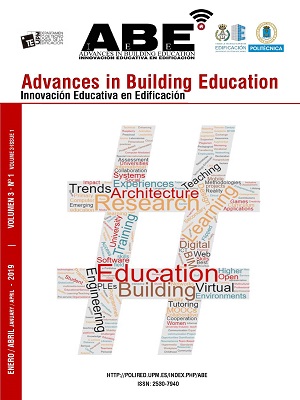New approaches to learning and assessing through escape rooms in English and Sciences areas = Nuevos enfoques para aprender y evaluar con "escape rooms" en las áreas de inglés y ciencias
DOI:
https://doi.org/10.20868/abe.2019.1.3881Keywords:
escape room, English, collaborative learning, assessment, competitiveness, inglés, aprendizaje colaborativo, evaluación, competitividadAbstract
Abstract
Some of the current and ongoing challenges ahead in the teaching of English in science areas include the competitiveness among students and the traditional ways to assess their progress. As a proposal in order to meet these goals, we advocate escape rooms that have been considered as a powerful tool in education. However, we want to incorporate a new element in this educational experience. Students do not have to “play” an escape room but to “create” an escape room. Throughout the creation of the escape room, students had to rely on their group members as there were some tasks that not everybody in the group knew how to solve. That emphasized the teamwork and cooperation rather than competitiveness. Students were revising all the knowledge learnt in different subjects to be able to create the tasks for the escape room and this helped us to assess the understanding of the content. Results showed creativity, collaboration, problem solving and critical thinking at the same time that the challenges and objectives established were completely met.
Resumen
Algunos de los retos actuales en la enseñanza del inglés en las materias de ciencias incluyen la competitividad entre los estudiantes y la manera tradicional de evaluar su progreso. Como propuesta para conseguir estos objetivos, proponemos las “escape rooms” consideradas como herramienta poderosa en educación. Sin embargo, el nuevo elemento que nosotros incorporamos a esta experiencia educativa no es que los alumnos “jueguen” sino que “creen” una “escape room”. A lo largo de la creación de la “escape room”, los estudiantes tuvieron que confiar en los miembros de su grupo ya que había tareas que no todos los componentes del grupo sabían cómo resolver. Esto manifestó el trabajo en equipo y la cooperación más que la competitividad. Los estudiantes revisaron todo el conocimiento aprendido en diferentes asignaturas para poder crear las tareas de la “escape room” y esto nos ayudó a evaluar el entendimiento del contenido. Los resultados mostraron creatividad, colaboración, resolución de problemas y pensamiento crítico al mismo tiempo que los retos y objetivos establecidos para esta experiencia educativa se cumplieron en su totalidad.
Downloads
References
. Reynolds, C. et al. (2010). Measurement and Assessment in Education. Pearson Education International.
. Fen Ng, C. and Kiat Ng, P. (2015). A review of intrinsic and extrinsic motivations of ESL learners. International Journal of Languages, Literature and Linguistics, vol. 1 (2), pp. 98-105.
. Amberg, M. et al. (2009). Designing an Integrated Web-Based Personal Learning Environment Based on the Crucial Success Factors of Social Networks. Research, Reflections and Innovations in Integrating ICT in Education, vol. 1, pp. 1075-1080.
. 2016. Stone, Z. The Rise of Educational Escape Rooms. The Atlantic. https://www.theatlantic.com/education/archive/2016/07/the-rise-of-educational-escape-rooms/493316/
. 2015. Ontario Escape Room Unconference. http://bgnlab.ca/blog/2015/10/27/ontario-escape-room-unconference-2015.html
. Khatibi, M. and Cowie, E. (2013). Language learning through interactive games.
http://muep.mau.se/bitstream/handle/2043/16116/EceandEvafinalexampaper1.pdf?sequence=2&isAllowed=y
. 1996. Chickering, A.W. and Ehrmann, S.C. Implementing the Seven Principles: Technology as Lever. American Association for Higher Education, vol. 49, pp. 3-6.
. Leigh Smith, B., MacGregor, J. (1992). What is Collaborative Learning?. The Pennsylvania State University.
. Shindler, J. (2009). Transformative Classroom Management: Positive Strategies to Engage all Students and Promote a Psychology of Success. John Wiley & Sons.
. Schwartz, D. (1999). The Productive Agency that Drives Collaborative Learning. In Collaborative Learning: Cognitive and Computational Approaches. Amsterdam: Pergamon.
. Klopfer, E. et al. (2009). Moving Learning Games Forward. Cambridge, MA: The Education Arcade.
. Cambridge University Press (2017). Educational Resources for Schools. http://www.cambridge.org/in/education/news/learning-not-spectator-sport
. Cambridge English Language Assessment (2015). University of Cambridge.
http://www.cambridgeenglish.org/images/177867-the-methodology-behind-the-cambridge-english-scale.pdf
. Alber, R. (2014). 6 Scaffolding Strategies to Use With Your Students. Edutopia. http://www.virginia.edu/blandy/blandy_web/education/MSI/Resources/Differentiation/6%20Scaffolding%20Strategies%20to%20Use%20with%20Your%20Students%20_%20Edutopia.pdf
. Nicholson, S. (2015). Peeking Behind the Locked Door: A Survey of Escape Room Facilities. Available at December 2017.
. Golub, J. (1988). Focus on Collaborative Learning. Classroom Practices in Teaching English. ERIC.
. Johnson, Johnson & Holubec (1999). El aprendizaje cooperativa en el aula. Buenos Aires: Paidós.
Downloads
Published
Issue
Section
License
ABE (Advances in Building Education / Innovación Educativa en Edificación) does not charge authors for processing or publishing an article and provides immediate Open Access to its content. All content is available free of charge to the user or his institution. Users are permitted to read, download, copy, distribute, print, search or link to the full text of articles, or use them for any other lawful purpose, without prior permission from the publisher or author. This is in accordance with the BOAI definition of open access.
- Authors retain the copyright and grant to the journal the right to a Creative Commons attribution / Non-Commercial / Non-Derivative 4.0 International (CC BY NC ND) License that allows others to share the work with an acknowledgement of authorship and non-commercial use.
- Authors may separately establish additional agreements for the non-exclusive distribution of the version of the work published in the journal (for example, placing it in an institutional repository or publishing it in a book).
Unless otherwise indicated, all contents of the electronic edition are distributed under a Creative Commons license.














